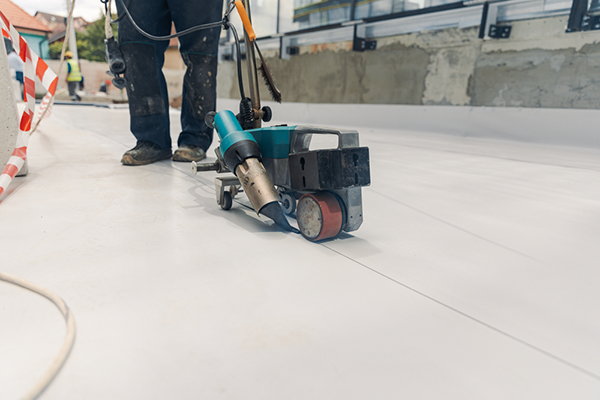A Commercial Roofing Tools List for Installing TPO Roofing Membranes
For roofing contractors looking to enter the commercial market, thermoplastic polyolefin (TPO) single-ply membranes are often the perfect choice. Not only are they among the fastest-growing roofing products in the low slope market, but they meet energy-saving roof reflectivity requirements and are less equipment- and labor-intensive than hot-applied modified bitumen and built-up roofs.

An added benefit for residential specialists who chose to start with TPO is that most steep slope tools and equipment are an important part of a comprehensive commercial roofing tools list. The only big-ticket items that may be of little use are pneumatic nailers and air compressors. However, contractors may find that asphalt shingles are still the product of choice on the steep and visible portions of light commercial projects.
Big-Ticket Items: Hot Air Welding Equipment
Two important tools that can make or break a TPO roofing job are hand-held and automatic hot air welders. A top-of-the-line hand-held tool could cost $400 to $700, but it's critical for welding flashing and overlaps. Choose a small, lightweight model with interchangeable nozzles. The skillful use of a hand-held welder for flashing and difficult-to-access roof areas requires practice. An ambidextrous worker may find the tool easier to handle.
Large, robotic hot air welders are used for high-speed, hot-air welding on TPO membrane seams. Variable speed control for the electric motor allows the operator to adjust the machine's travel speed along the seam. The welder's movement along the seam is determined by the heat setting based on air temperature.
Today's most powerful hot-air welders for TPO roofing membranes can weld up to 40 and even 60 feet per minute. Although they often cost upwards of $5,000, these welders pay for themselves on large roofing projects. However, it's unlikely that a contractor new to TPO roofing will be tackling a 200,000-square-foot "big box" roofing project immediately.
Consider the $3,000 or so you can expect to pay for a 230-volt, computer-controlled automatic welder as an investment. Less expensive semiautomatic welding equipment can offer consistent welds and work three times faster than manual welding. However, its performance may not meet the future needs of a growing business.
Large, digitally monitored robotic welders can achieve consistent overlap welding performance, but they cannot adapt to changing environmental conditions the way a human welder can. Periodic test welding and proper maintenance are keys to a good spec weld.
Keeping the Power Flowing Smoothly
Although "house-supplied" power is enough for hand-held and automatic welders to get the power they need, investing in a 240-volt portable generator is a smart move. Beware of relying on power sources that are used for other equipment and cycle on and off. Power surges, service disruptions or insufficient power may adversely impact welding quality.
The last tool that deserves special mention is the seam probe. Professionals typically use a blunted scratch awl, cotter key puller or other round-tipped tools to test a seam edge. It is imperative to avoid scoring the recently welded membrane. Any penetration of the probe into the seam indicates a void in the weld, which must be patched. Continuous seam probing will sharpen the probe's tip, so it is important to blunt the tip of the instrument regularly.
Commercial Roofing Tools List for TPO Membranes
- Aluminum tape.
- Brooms (soft- and stiff-bristled).
- Caulking gun.
- Chalk line and measuring tape.
- Several cordless electric drills, drivers or rivet guns.
- Gravel-moving equipment.
- Grounded extension cord.
- Lawn or linoleum rollers.
- Metal crimpers and snips.
- Portable generator.
- Reciprocal saw.
- Roof fastener pull-out tester.
- Roof squeegees for applying adhesives.
- Rubber mallet.
- Seam probe.
- Shears.
- Silicone rubber roller.
- Solvent-resistant pans.
- T-square.
- Utility knife with rubber handle.
- Vise-grip.
You can refine your commercial roofing tools list over the years through training and communication with fellow roofers. Whether it's your first commercial job or the first project for your new roofing business, a thorough checklist can prepare you to tackle TPO.